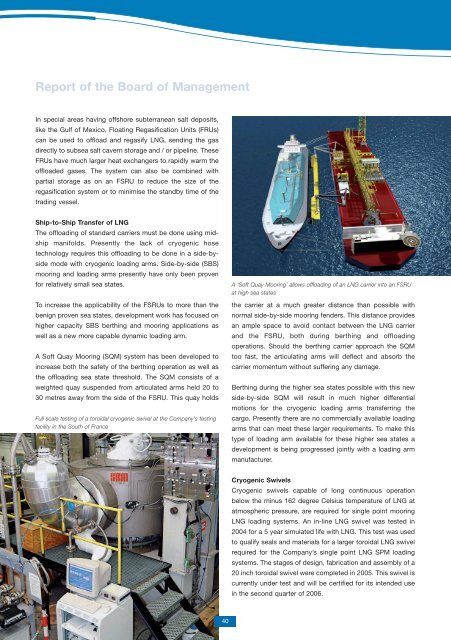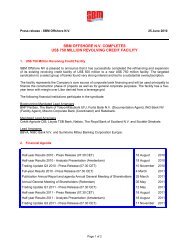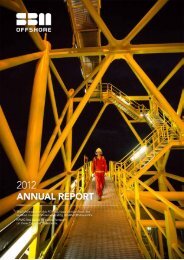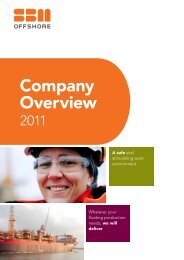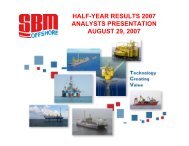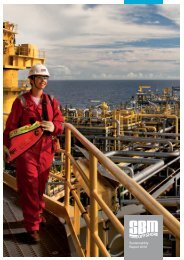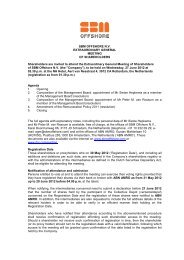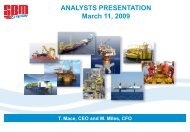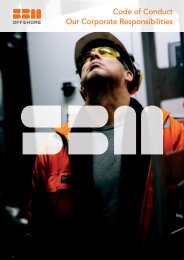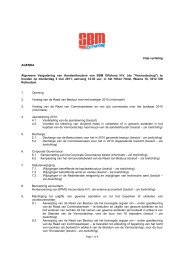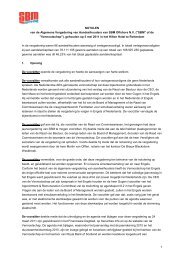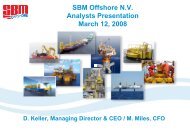2005 Annual Report - SBM Offshore
2005 Annual Report - SBM Offshore
2005 Annual Report - SBM Offshore
You also want an ePaper? Increase the reach of your titles
YUMPU automatically turns print PDFs into web optimized ePapers that Google loves.
<strong>Report</strong> of the Board of Management<br />
In special areas having offshore subterranean salt deposits,<br />
like the Gulf of Mexico, Floating Regasification Units (FRUs)<br />
can be used to offload and regasify LNG, sending the gas<br />
directly to subsea salt cavern storage and / or pipeline. These<br />
FRUs have much larger heat exchangers to rapidly warm the<br />
offloaded gases. The system can also be combined with<br />
partial storage as on an FSRU to reduce the size of the<br />
regasification system or to minimise the standby time of the<br />
trading vessel.<br />
Ship-to-Ship Transfer of LNG<br />
The offloading of standard carriers must be done using midship<br />
manifolds. Presently the lack of cryogenic hose<br />
technology requires this offloading to be done in a side-byside<br />
mode with cryogenic loading arms. Side-by-side (SBS)<br />
mooring and loading arms presently have only been proven<br />
for relatively small sea states.<br />
To increase the applicability of the FSRUs to more than the<br />
benign proven sea states, development work has focused on<br />
higher capacity SBS berthing and mooring applications as<br />
well as a new more capable dynamic loading arm.<br />
A Soft Quay Mooring (SQM) system has been developed to<br />
increase both the safety of the berthing operation as well as<br />
the offloading sea state threshold. The SQM consists of a<br />
weighted quay suspended from articulated arms held 20 to<br />
30 metres away from the side of the FSRU. This quay holds<br />
Full scale testing of a toroidal cryogenic swivel at the Company’s testing<br />
facility in the South of France<br />
40<br />
A ‘Soft Quay Mooring’ allows offloading of an LNG carrier into an FSRU<br />
at high sea states<br />
the carrier at a much greater distance than possible with<br />
normal side-by-side mooring fenders. This distance provides<br />
an ample space to avoid contact between the LNG carrier<br />
and the FSRU, both during berthing and offloading<br />
operations. Should the berthing carrier approach the SQM<br />
too fast, the articulating arms will deflect and absorb the<br />
carrier momentum without suffering any damage.<br />
Berthing during the higher sea states possible with this new<br />
side-by-side SQM will result in much higher differential<br />
motions for the cryogenic loading arms transferring the<br />
cargo. Presently there are no commercially available loading<br />
arms that can meet these larger requirements. To make this<br />
type of loading arm available for these higher sea states a<br />
development is being progressed jointly with a loading arm<br />
manufacturer.<br />
Cryogenic Swivels<br />
Cryogenic swivels capable of long continuous operation<br />
below the minus 162 degree Celsius temperature of LNG at<br />
atmospheric pressure, are required for single point mooring<br />
LNG loading systems. An in-line LNG swivel was tested in<br />
2004 for a 5 year simulated life with LNG. This test was used<br />
to qualify seals and materials for a larger toroidal LNG swivel<br />
required for the Company’s single point LNG SPM loading<br />
systems. The stages of design, fabrication and assembly of a<br />
20 inch toroidal swivel were completed in <strong>2005</strong>. This swivel is<br />
currently under test and will be certified for its intended use<br />
in the second quarter of 2006.


